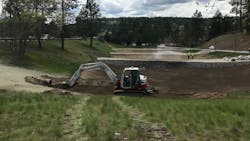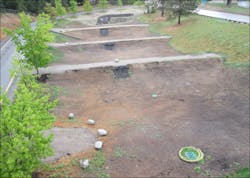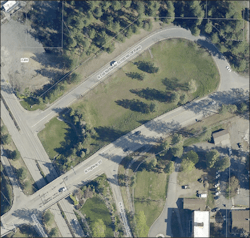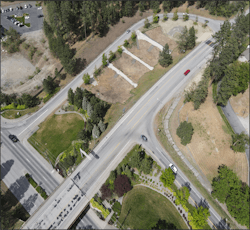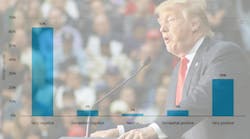Project Profile: Stormwater Outfall Volume Reduction Program
The City of Coeur d’Alene is located along the north shore of Lake Coeur d’Alene and the Spokane River in north Idaho. Renowned for summer watersports and winter snow sports, the City is rapidly growing. This population boom has resulted in a substantial increase in trash and pollution (heavy metals, nutrients, suspended solids, thermal, hydrocarbons, etc.) entering the lake and river through the City’s 13 stormwater outfalls.
Although these outfalls are permitted under the City’s Municipal Separate Storm Sewer System (MS4) permit, the City desired to reduce the volume of untreated stormwater entering the surrounding waterways. The Mayor and City Council prioritized improving lake and river water quality by treating stormwater runoff through a Stormwater Outfall Volume Reduction Program (SOVRP).
The SOVRP directs the City’s Drainage Utility to evaluate the watershed within their MS4 boundaries and develop solutions to reduce the volume of stormwater runoff piped to Lake Coeur d’Alene and the Spokane River. The City Streets and Engineering Department, with Drainage Utility Manager Kim Harrington, evaluated the entire stormwater system for potential projects that could be completed to reduce or completely remove the volume of stormwater discharging into the surface waters of the lake and river. Several potential projects were identified where unused properties existed near stormwater outfalls.
The City and HMH analyzed the feasibility of diverting runoff from the stormwater system into a treatment area utilizing a large Idaho Transportation Department gore area located between US-95 and an off-ramp to Northwest Boulevard. US-95 and Northwest Boulevard are both heavily traveled arterial streets, providing high visibility for this project. The two-acre area was sparsely planted with no current use to the state.
After entering a formal agreement with the Idaho Transportation Department to use their property, the City of Coeur d’Alene Drainage Utility and its consultant developed a concept for a tiered infiltration bed system utilizing vegetated swales and drywells. HMH Engineering evaluated the watershed’s stormwater system using Autodesk Storm and Sanitary Analysis as well as Esri’s ArcGIS. Hydrology of the watershed was examined using several different methods including modified rational, Technical Release 55 (TR-55) and regression equations.
The stormwater treatment area design accounted for frozen ground, future roadway expansion, redundancy and ease of maintenance. The design included 20 drywells to be installed within three tiers of a swale to capture and treat stormwater. A catch basin at the low end of the tiered infiltration swale system allows excess stormwater to return to the piped system and ultimately to the outfall if the swale system is overwhelmed. Additionally, an emergency overflow was designed within a manhole at the upstream end of the infiltration bed system, allowing the City to completely bypass the infiltration swale if necessary.
City crews, led by Justin Kimberling, began construction on the project in the winter and early spring of 2021, excavating large flat swale areas separated by earthen berms to create the tiered infiltration bed system. Overflow pipes were installed near the top of each berm to allow excess stormwater to enter the next swale. Riprap was installed in critical areas to prevent erosion of the soil during turbulent discharges of stormwater into the swale. The berms were constructed to provide maintenance vehicle access to the swale system. Once the tiers of the swale were constructed, the City hired a contractor to install a 24” pipe beneath US-95 into the top tier of the swale system. A temporary plug was installed in the pipe to prevent stormwater from entering the swale until final riprap installation and hydroseeding could be completed. Once vegetation is fully established, the plug will be removed, diverting all stormwater from the 210-acre urban watershed into the swale.
The City is currently working with the Idaho Department of Environmental Quality, Idaho Panhandle Stormwater Erosion Education Program (SEEP) and University of Idaho to develop a water quality monitoring system. This will allow the City to determine stormwater runoff treatment effectiveness for use on future SOVRP efforts. Flow monitors will be installed at the entrance to the tiered infiltration bed system and the overflow pipes to determine the quantity of stormwater that is entering the system and potentially leaving the system. A water quality sampling device will be installed at the entrance to the swale system to determine what pollutants are present in the stormwater and are therefore diverted from discharging into the Spokane River. Groundwater monitoring wells are to be installed in the first tier of the swale system to determine the pollutant removal from infiltration through the topsoil and vegetation. It is estimated that the swale system will remove approximately eight pounds of total phosphorus, 50 pounds of total nitrogen, 830 pounds of total suspended solids, 0.2 pounds of lead and three pounds of zinc during a 10-year storm event.
The total project cost for materials, engineering services and contractor work was approximately $200,000, not including labor costs of City employees involved with the project. Total time spent by City crews was approximately 1,200 hours over a period of four months. Costs for the project were paid by the City’s Drainage Utility, which collects fees from residential and commercial properties to construct and maintain the City’s stormwater system, totaling approximately 10,000 acres.
The project has received many accolades from the community and regulatory agencies for taking a big step toward improving water quality. In June 2021 the project was awarded an Achievement Award from the Association of Idaho Cities. Springing off of the momentum of this project and the positive feedback received, the City is looking to begin another Stormwater Outfall Volume Reduction Program project in the spring of 2022 on a 66-acre watershed. Hydraulic and hydrologic modeling have already been completed. SW
Chris Bosley, P.E., has a civil engineering background that includes design of urban streets, interstate highways, roundabouts, traffic calming, stormwater facilities and pedestrian and bicycle facilities. He has 23 years of experience in transportation planning and design with an emphasis on non-motorized transportation. For most of his career, Bosley has been working on transportation projects for private consultants, but he has spent the past five years as the City Engineer for the City of Coeur d’Alene, Idaho.
Published in Stormwater magazine, August 2021.
About the Author
Chris Bosley
Chris Bosley, P.E., has a civil engineering background that includes design of urban streets, interstate highways, roundabouts, traffic calming, stormwater facilities and pedestrian and bicycle facilities. He has 23 years of experience in transportation planning and design with an emphasis on non-motorized transportation. For most of his career, Bosley has been working on transportation projects for private consultants, but he has spent the past five years as the City Engineer for the City of Coeur d’Alene, Idaho.
